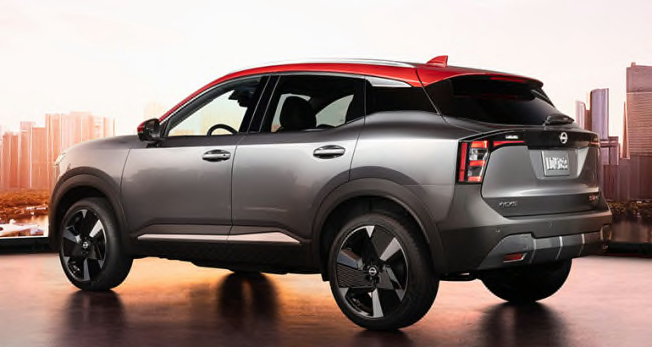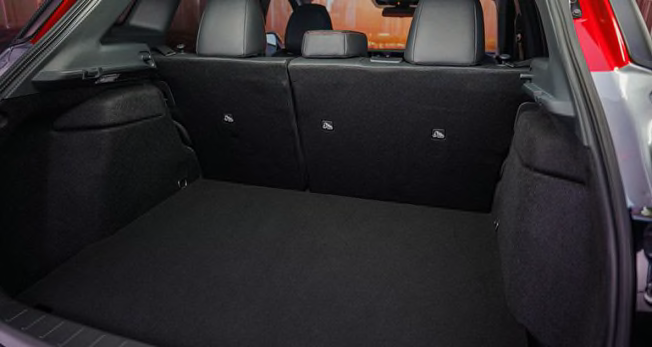Preview: Redesigned 2025 Nissan Kicks Grows Slightly, Gains AWD
More power and elbow room should further broaden its appeal

The redesigned 2025 Nissan Kicks is larger, more powerful, and for the first time, offered with all-wheel drive. And its suite of active safety and driver assistance features is quite robust. This versatile hatchback is growing up and kicking higher.
Its length has increased by 3 inches, and nearly every other dimension expanded by 2 inches, to the benefit of passengers and cargo space. This follows the size creep for the class, with most models increasing in proportions and ability with each generation.
- Nissan Kicks: CR's Take Outside Inside What Drives It Active Safety and Driver Assistance
The 1.6-liter engine has been replaced by a more powerful 2.0-liter four-cylinder, as warranted by the added girth.

Photo: Nissan Photo: Nissan
CR's Take
Even at the end of its model run, the Nissan Kicks stands tall among subcompact hatchbacks. The availability of all-wheel drive and a wee bit gain in size means the redesigned Kicks will now be compared against subcompact SUVs, such as the strong-performing Subaru Crosstrek, Toyota Corolla Cross, and Honda HR-V. We expect the Nissan to have a pricing advantage against those slightly larger models.
The Kicks moves to a larger 2.0-liter four-cylinder engine, similar to the setup in the current Sentra. We found that powertrain to be pleasant, with quick acceleration and commendable fuel economy. (The Kicks and Sentra have a similar curb weight in front-drive, but AWD in the top Kicks SR trim is about 250 pounds heavier than the Sentra we last tested.)
Overall, the Kicks seems to have grown up a bit by all measures, following the path of its key rivals. The incremental size increase should make it a bit more livable, with increased passenger and cargo space, and the addition of AWD expanding its appeal.
Outside
Kicking things up a notch, the redesigned subcompact stretches 3 inches longer than the first-generation Kicks. It is about 2 inches wider and 2 inches taller. Those changes should create a bit more elbow room.
The styling is evocative of the latest Nissan models, yet it is quite different. It is distinguished by a wide grille, a beltline crease that runs from front to back, and a flattened rear liftgate. The two-tone scheme shown on the SR trim looks snazzy. The overall presentation looks new, fresh, and decidedly a bit more like an SUV.

Photo: Nissan Photo: Nissan
Inside
The cabin appears to follow the latest design trend, pairing two horizontal screens across the dash—on the top trim. The Kicks S and SV have a 7-inch instrument display, whereas the SR is fitted with a 12.3-inch screen, as shown above.
There is a similar class system regarding the center infotainment screen, with the S getting just a 7-inch touchscreen and a basic four-speaker audio system.
The higher SV and SR trims have a center 12.3-inch touchscreen. Their system is wireless Android Auto and Apple CarPlay compatible, and it comes with a wireless phone charging pad. The SV also has just four speakers, and the SR bumps it up to six. A 10-speaker Bose audio system is optional on the SR, and it includes head restraint speakers.
These configurations should allow the S to be priced aggressively, but it will seem out of step for 2025 for a car to have such small screens, so few speakers, and not be CarPlay compatible.
There are three USB ports up front on all versions, and the SR gains two more for the rear.
The steering wheel has a flat bottom, like some race cars. This adds a sporty flair, perhaps evoking the Nissan Z, and it makes it easier to slide into the driver’s seat. Front seat adjustments are manual on all trims.
The S comes with basic cloth upholstery. The SR has a combination of “leatherette” and red/black cloth. Heated front seats are optional on SV and SR. The seats are described as “zero gravity” designs, a descriptor that portends of fatigue-reducing body support. This tech is more often associated with luxury models; we look forward to seeing how this has been applied to the Kicks, especially as seats in subcompact vehicles tend to be a bit basic and not ideal for long-distance travel.
Nissan notes that the front two cup holders can accommodate 30-ounce drinks, and the bottle holders on the doors, specifically, can hold a 32-ounce Yeti tumbler. Clearly, hydration is a chief concern among the target buyers.
Option packages on the SV and SR include a panoramic sunroof with a shade.
The dimensions reveal that the Kicks has a bit more shoulder room for front and back passengers, with the second row also gaining a smidge of knee room. The increased size also brings more cargo space, something we’ll look forward to measuring with our luggage. The wider opening should enhance versatility and ease of loading.

Photo: Nissan Photo: Nissan
What Drives It
As the Kicks grew, it was only natural that the engine would as well. The former 122-hp, 1.6-liter four-cylinder engine was supplanted by a 141-hp, 2.0-liter four-cylinder engine. A continuously variable transmission is used again.
Each trim can be configured with either front- or all-wheel drive. AWD adds about 200 pounds.
EPA fuel economy figures haven’t been released yet. Those will be important in how this Kicks compares against its growing competition. The Sentra that we tested recorded 32 mpg overall in our tests.
Active Safety and Driver Assistance
The Kicks comes with automatic emergency braking with pedestrian detection, blind spot warning, rear cross traffic warning, reverse automatic emergency braking, lane departure warning, and automatic high beams.
Other conveniences include:
• The clever easy-fill tire alert uses exterior lights and the horn to communicate when the tires have been inflated properly.
• A rear occupant alert that uses door logic: If a rear door was opened prior to the current trip, the Kicks will remind the driver to check the rear seat when the ignition is turned off to ensure no wee travelers, furry or otherwise, are left behind.
• A driver attention monitor ensures the driver is attentive and warns when it detects the driver is acting fatigued.
The Kicks S and SV include adaptive cruise control. The SR brings ProPilot Assist, which builds on that by adding steering assistance to help the vehicle stay centered in its lane on highways and thereby ease some driving stress. ProPilot Assist can also help in traffic jams, with the ability to bring the vehicle to a stop, hold it in place, and then proceed when traffic advances.
The SR also brings a 360-degree surround-view camera—a feature that is helpful when parking in tight spots.




















